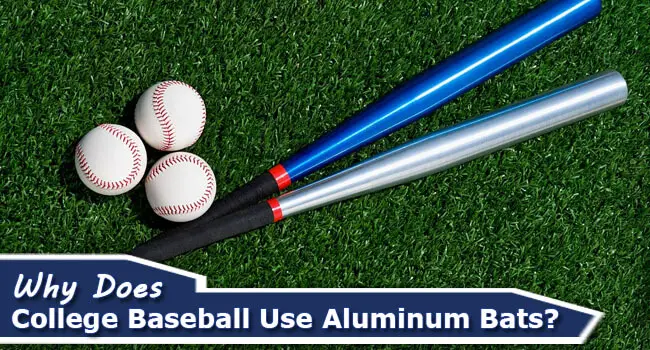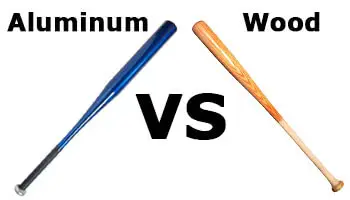
A college baseball game is played on the intercollegiate level at the institutions of higher education. But why does college baseball use aluminum bats?
Why Does College Baseball Use Aluminum Bats?
Aluminum bats are quite different from wooden bats in weight as well as in performance. They are much lighter in weight that is more than five ounces. Its barrels are bigger due to its lightweight. Thus, aluminum bats can be swung faster than a wooden bat.
The hardness and resilience of aluminum bats result in higher speed and performance when the ball comes off the bat. In Major Baseball League, the players use wooden bats because aluminum bats were used to dominate at the lower levels of the baseball game. Therefore, such bats are preferred in little college leagues.
What are College Bats Made Of?
Not all baseball bats are made up of the same material. Professional leagues use wooden baseball bats, but players at all levels of the amateur game including college play use metal or aluminum bats. Many new rules and regulations are implemented in college regarding the type of material used for baseball bats.
In the college baseball season of 2011, the National Collegiate Athletic Association permitted only aluminum alloy bats during the game. All alloy bats are a combination of zirconium, copper, magnesium, and aluminum. These elements can be mixed in several ways to create different bats with different weights and durability.
There are four popular mixtures of alloys that are used to create alloy bats. A standard alloy type is used in most of the baseball bats. 7050 models of the baseball bats are a more advanced version of 7046 models.
These are created by a mixture of more zirconium, magnesium, and copper. It makes the baseball bat stronger and also increases its durability. Now, the 7055 models of the baseball bat have more zirconium for increased levels of durability. The C555 model is best-performing alloy bats that include a small amount of scandium for increased bat strength.
Until 2009, composite bats were the famous and most widely used baseball bat. After 2009, the NCAA has banned the use of composite bats because of the dangerous batted-ball exit speeds. Baseball players learned to roll the composite bats.
They were also taught how to hit the ball harder and farther due to increased trampoline effect inside the barrels. Composite bats with graphite and titanium were popular choices. It made the bats lighter in weight and stronger in hitting the ball. It also increases the bat speed of the player.
Why is Aluminum Bat Better than Wooden Bat?

Ever since the introduction of aluminum bats in the early 1970s, they have dominated the youth and amateur baseball market. Every year, new designs and models of the baseball bats are introduced. Each one is claimed to be better than the previous model. Every new bat has a wider sweet spot which results in more power, better feel, and high performance.
Everyone who so ever used an aluminum bat knows that they perform far better than the wooden bats. The balls that come off from the metal bats are much faster as compared to the wooden bats. In recent years, metal vs wood has become a controversial topic that claims that higher batted balls can put the pitchers and fielders at a higher risk for injury.
Therefore, such injuries led to call for restrictions on bat performance. At that time, the controversy between the metal and the wooden baseball bats was so heated that it resulted in threats of lawsuits between bat manufacturers, safety watch organizations, and the sport regulatory groups.
Around 1988, the NCAA began to set on the limitation on the performance of aluminum bats. On October 31, 2002, the media reported that the Massachusetts Interscholastic Athletic Association was considering banning the use of aluminum bats in high school. The controversy also claimed that aluminum baseball bats are more dangerous than wooden baseball bats.
What are the Risks of Using Aluminum Bats?
Because of the injury factors, the NCAA banned the use of aluminum bats in college baseball. From this point, the manufacturers have to manipulate the size and the weight of the baseball bats so that they do not create any hazardous injury or any player-development problem for the college level baseball players.
Lightweight baseball bats are used for fast bat speed during swings that result in a greater hit-ball velocity. The ball exits with higher velocity from a lighter aluminum baseball bat than a wooden baseball bat. The fast speed of aluminum bats increases the danger of injury to defensive players on the field.
What are the Changes Made by the NCAA Committee for Using an Aluminum Bat?
In 1975, the aluminum bats were implemented in college. It was controversial to use aluminum bats at that time. All the supporters of aluminum or composite bats claimed that it increases offensive performance. The speed of the ball off by the aluminum bat is much faster as compared to the wooden bat. Many arguments were happening against the use of aluminum and wooden bats.
The aluminum bats are not safe to use. These bats do not prepare players for next level playing, like professional players that use wooden baseball bats to play the game. The NCAA changed the requirements for the aluminum bats by reducing the maximum allowed exit speed of the ball. So, it is said to produce more like a wooden bat in the season of 2011. Later in 2011, there was a total drop-off for the aluminum bats in the college level of play.
Final Thoughts
Aluminum baseball bats are used in the college or high school level. But why does college baseball use aluminum bats? The aluminum baseball bats are much faster as compared to wooden baseball bats. They are comparatively lighter and give a more trampoline effect. It provides strength to the player to hit the ball with a swing and increases its performance.



